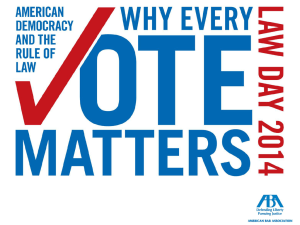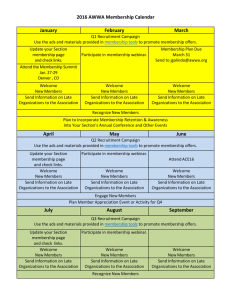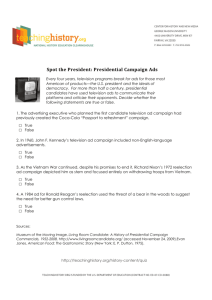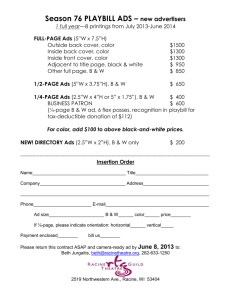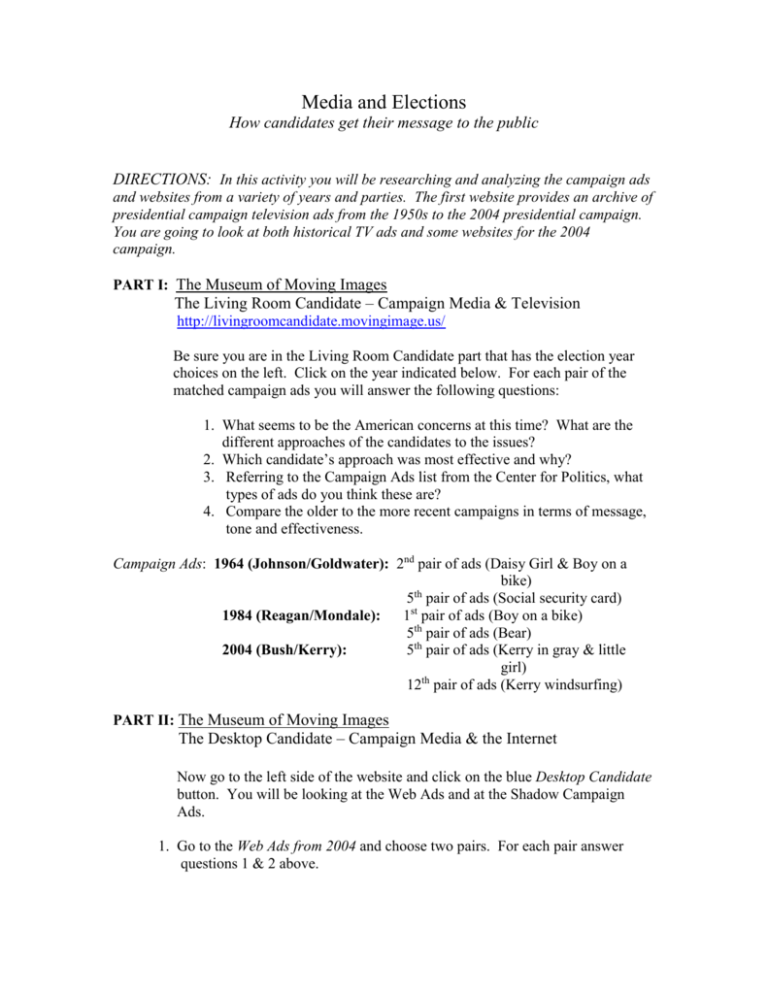
Media and Elections
How candidates get their message to the public
DIRECTIONS: In this activity you will be researching and analyzing the campaign ads
and websites from a variety of years and parties. The first website provides an archive of
presidential campaign television ads from the 1950s to the 2004 presidential campaign.
You are going to look at both historical TV ads and some websites for the 2004
campaign.
PART I: The Museum of Moving Images
The Living Room Candidate – Campaign Media & Television
http://livingroomcandidate.movingimage.us/
Be sure you are in the Living Room Candidate part that has the election year
choices on the left. Click on the year indicated below. For each pair of the
matched campaign ads you will answer the following questions:
1. What seems to be the American concerns at this time? What are the
different approaches of the candidates to the issues?
2. Which candidate’s approach was most effective and why?
3. Referring to the Campaign Ads list from the Center for Politics, what
types of ads do you think these are?
4. Compare the older to the more recent campaigns in terms of message,
tone and effectiveness.
Campaign Ads: 1964 (Johnson/Goldwater): 2nd pair of ads (Daisy Girl & Boy on a
bike)
th
5 pair of ads (Social security card)
1984 (Reagan/Mondale): 1st pair of ads (Boy on a bike)
5th pair of ads (Bear)
2004 (Bush/Kerry):
5th pair of ads (Kerry in gray & little
girl)
th
12 pair of ads (Kerry windsurfing)
PART II: The Museum of Moving Images
The Desktop Candidate – Campaign Media & the Internet
Now go to the left side of the website and click on the blue Desktop Candidate
button. You will be looking at the Web Ads and at the Shadow Campaign
Ads.
1. Go to the Web Ads from 2004 and choose two pairs. For each pair answer
questions 1 & 2 above.
2. Click on the 2004 Shadow Campaign and read the intro page. Choose four
commercials from different groups and do the following.
a) Before you watch the ad, just using the name of the group, guess which
candidate this ad may be supporting.
b) After watching the ad, evaluate what was the message and how
effectively was it given, was the information believable, did the
candidate seem to have a part in making the ad?
PART III: Media Satire
If you have time in the end go to the following website known as Jib Jab.
http://www.jibjab.com/originals/what_we_call_the_news
View the media satire “What We Call the News” which is linked here and then look at
“This Land is Your Land” or “205” if you have time. You do not need to do anything
with these except comment on whether you think there is any bias in this site.
YLI - How Do Candidates Get Your Attention?
A Guide to Campaign Advertisements
A. Testimonial - endorsements from celebrities and other well-known people.
Example: Michael Jordan's endorsement of Bill Bradley for President; Senator Warner's endorsement
of George Allen for Senate; any local celebrity or well known community leader's public endorsement
of a candidate for office.
B. Mudslinging - often referred to as "attack ads," the TV, radio and print advertisements make
assertions about the opponent in a variety of unflattering ways. Name-calling and/or groundless
assertions about one candidate by his/her opponent. This advertising strategy is used by a candidate
primarily to create a negative impression of one's opponent. This strategy may backfire and create a
negative impression of the candidate who is responsible for the creation of the negative ad if used
excessively, or in a manner that is perceived as false, deceptive, "tasteless" or "going too far."
Example: The Bush "Rats" Ad; 1996 Democratic Presidential and Congressional commercials that
"morphed" the candidate into images of Pat Robertson or Newt Gingrich.
C. Transfer - Use of popular symbols to create a positive connotation for the candidate or the use of
negative or controversial symbols to create a negative connotation of one's opponent.
Example: Positive: Ads that feature pleasant music, beautiful outdoor country or rural scenery, happy
families, playful children, successful teams or businesses etc. Negative: Talking about an opponent's
record with ominous music in the background, using black and white photos, visually shocking images
such as oil spills, home foreclosure, car accidents, prison bars etc. Images of one's opponent in slow
motion causing the eye's to blink slowly, thereby giving the impression of disinterest, laziness and/or
intoxication.
D. Card stacking - Use of statistics, often in a one-sided manner; the omission of information that is
crucial to drawing an informed and balanced conclusion.
Example: 95% of citizens surveyed support Mrs. Jones for City Council; "Time after time, my
opponent voted against legislation that would have supported new jobs in our community."
E. Plain Folks - An attempt by a candidate to appeal to the average voter as just "one of the
people."
Example: Lamar Alexander in 1996 wearing his trademark red and black-checkered shirt. Any
candidate ad where he or she appears with no jacket or suit, shirtsleeves rolled up and/or wearing a
sweater. Usually doing everyday task such as shopping at the supermarket or walking down a street or
"visiting" with neighbors. The negative version of this would be "man on the street" interviews where the
interviewees are critical of the opponent.
F. Glittering Generalities - Usually the first type of ad used in a campaign, these spots are
designed to introduce a candidate to the voters. Needless to say, like any introduction, these types of
ads are almost always very positive. Designed to leave the viewer with a very good first impression.
This ad type uses very vague words and phrases that have a positive effect on the viewer and appeal
to a variety of interests.
Example: Ads use images and phrases that are virtually impossible not to like such as: "Working for
your family," "Building a Bridge To The Future," "Saving Our Schools" "Improving America" "Saving
Social Security" "Building One America" etc. The images are usually of a perfect world with happy
families and children in pleasant surroundings on sunny days with blue skies or images of the
candidate hard at work, sleeves rolled up, actively engaged in conversation with people in a
"responsible" business environment.
G. Bandwagon - Similar to card stacking, this is an attempt to convey a sense of momentum and to
generate a positive "everybody's doing it so you should too" mentality.
Example: Voice-overs in commercials stating "Polls show Robert Stone leading in the race for the
United States Senate." Large groups of people greeting a candidate or carrying signs in support.
Group testimonials and/or corporate endorsements such as: "Endorsed by the National Association of
Retired Persons," or "Endorsed by the National Education Association."
H. Contrast Ad - Juxtaposing positive images of one's candidacy with negative images of the
opponent in the same ad.
Example: Split screens with Hillary Clinton in color moving at regular speed and her opponent Rick
Lazio in black and white moving in slow motion. Images of two candidates on screen as a voice over
denounces the opponent followed by a red X appearing over the opponent's face.
_____________________________________________
Copyright © 2002 U.Va. Center for Politics. All rights reserved.



